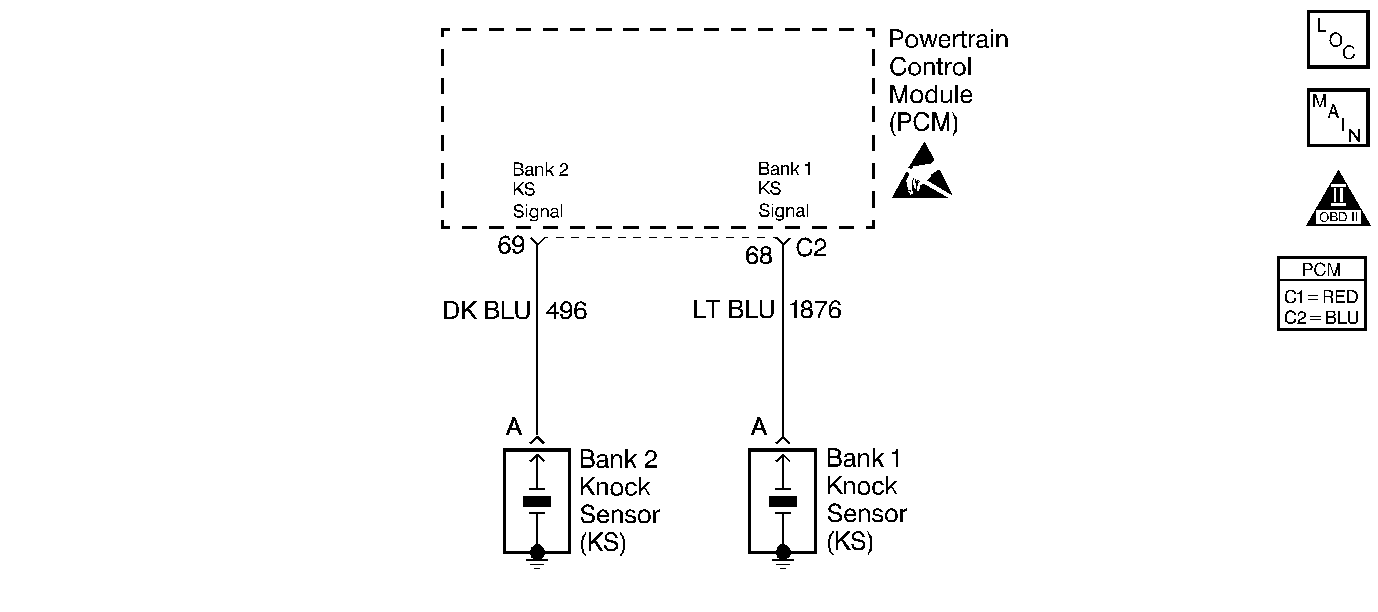
Circuit Description
The Knock Sensor detects engine detonation. The Powertrain Control Module (PCM) retards the electronic spark timing based on the signal being received. The Knock Sensor produces an AC signal. The amplitude and frequency are dependent upon the knock level. The KS module sends a signal to the PCM. The PCM then retards the spark timing in order to reduce the detonation.
Diagnostic Aids
While observing the knock signal on the scan tool, there should be an indication that a knock is present whenever a knock can be heard. An engine knock is most likely to occur under high engine load conditions.
Test Description
The numbers below refer to the step numbers on the diagnostic table.
-
The OBD System Check prompts the technician to store the Freeze Frame Data in the scan tool. This will create an electronic copy of the freeze frame data taken when the fault occurred that can be referred to later.
-
If the engine has an internal problem which is creating a knock, the Knock Sensor may be responding to the mechanical noise.
-
The scan tool displays Knock Sensor activity in counts approximately 16-22 at idle. The counts should rise when the engine speed increases and the counts should decrease when the engine speed decreases.
-
This checks that the internal resistance of the knock sensor is within an acceptable range.
-
Check the Knock Sensor connections for loose terminals or corrosion.
Step | Action | Value(s) | Yes | No |
|---|---|---|---|---|
1 | Was the Powertrain On-Board Diagnostic (OBD) System Check performed? | -- | ||
Is the engine knock present? | -- | |||
Does the KS activity increase and decrease with the engine speed? | -- | Go to Diagnostic Aids | ||
4 |
Caution: Avoid contact with moving parts and hot surfaces while working around a running engine in order to prevent physical injury. Tap on the engine block near the Knock Sensor. Is spark knock indicated? | -- | ||
Is the resistance within the specified value? | 90 Kohms-110 Kohms | |||
6 |
Is an AC voltage indicated while tapping near the sensor? | -- | ||
Check the Knock Sensor connections. Was a problem found? | -- | |||
8 | Check for an open or shorted Knock Sensor signal circuit. Was a problem found? | -- | ||
9 | Replace the Knock Sensor. Refer to Knock Sensor Replacement . Is the problem still present? | -- | ||
10 | Replace the KS Module. Refer to Knock Sensor Replacement . Is the problem still present? | -- | ||
11 | Replace the PCM. Refer to Powertrain Control Module Replacement . Is the problem still present? | -- | -- | |
12 | Repair as necessary. Is the action complete? | -- | -- | |
13 | Repair the basic engine problem. Refer to Engine Mechanical. Is the action complete? | -- | -- | |
14 | Operate the vehicle within the conditions under which the original Symptom was noted. Does the system now operate properly? | -- | System OK |
